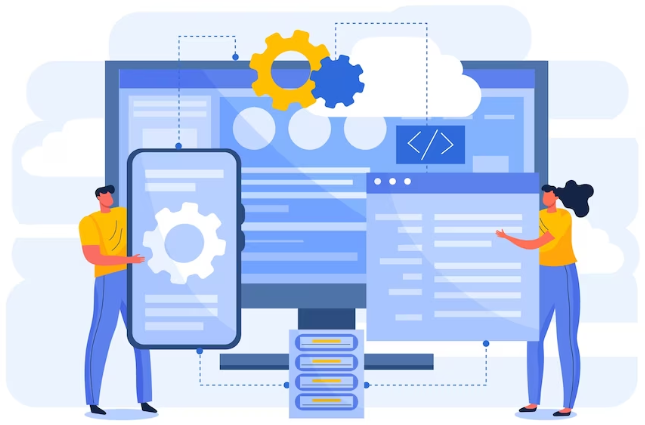Developers find software process models to be valuable tools for outlining each stage of their projects. They support project managers with process planning, cost estimation, problem identification, and team and customer communication. It might be beneficial to find out more about process models and how they can support you if you work in software development.
In this post, we define software process models and go over some of the most typical kinds of models you may run into.
The Evolution of Software Development Process Models
A software process model is a digital or handwritten model that describes the steps involved in software development. Process models assist in giving the custom software solutions team and the client a visual depiction of the development process to assess.
This serves as a record of the team’s development process going forward and aids in determining the best procedure to follow for a given piece of software. It also helps them see early problems or financial limitations.
The software development ecosystem has changed dramatically over the years, and understanding the importance of process models in 2024 requires comprehending this history.
After proving to be successful at first, the Waterfall model—a strict and methodical approach to software development—had trouble adjusting to evolving requirements and client input. With the development of technology, the Iterative model—which divides projects into smaller iterations for more adaptability—arose as a bridge between the rigid Waterfall model and agile methodologies. However, the emergence of Agile in the early 2000s signaled a paradigm change, emphasizing short iterations, customer participation, and adaptability.
Modern software development process models have emerged due to this growth, meeting the various demands of projects and enabling developers and organizations to select the model that best suits their unique objectives and difficulties. These models are crucial resources for navigating the rapidly evolving field of technology.

Software developers in the business generally use this four-step technique to organize software operations into a similar pattern:
* Specification. The team establishes the primary features of the software application they are developing. They also consider the project’s limitations and the particular characteristics that the finished software product should have.
* Development and implementation. The team programs and develops the software within the constraints of the specification phase. This comprises all of the coding, planning, 3D design and early planning aside from determining the project’s specifications.
* Verification and validation. The group confirms that the finished software application meets client requirements and quality standards. The team provides the prototype to the client for assessment.
* Evolution. The team considers user input and modifies the program to fit new requirements or enhance existing ones for enhanced functionality. If they provide post-development support for their program, this might be a continuous activity for the team.
Modern Software Process Models
Rapid technology breakthroughs, fluctuating client expectations, and a cutthroat commercial climate characterize the software development scene. Selecting the appropriate process model is a calculated move to maintain competitiveness and complete projects successfully.
Agile Model
Often heralded as a software development game-changer, this framework places a premium on adaptability and client involvement. It’s a collection of ideals and concepts prioritizing rapid delivery of a minimal viable product (MVP), flexibility in the face of change, and iterative advancement.
Agile’s adaptability to changing needs and market demands is one of its key advantages. Being ready to change course quickly may make or ruin a project in the ever-changing corporate climate. Sprints, or brief development cycles, are how Agile does this. Scrums include developing, testing, and delivering tiny amounts of functionality. This iterative process makes sure that the product can adjust to changing market conditions and stays in line with client demands.
Waterfall Model
The Waterfall model is a more conventional and linear method of software development, in contrast to Agile. Among the most straightforward and efficient software process models is the Waterfall approach. The Waterfall model makes the development process easier to understand by showing each stage as a distinct, sequential step. You may quickly review the whole development process and make necessary adjustments as it progresses.
The Waterfall approach paradigm performs admirably for straightforward software development projects that probably won’t undergo substantial changes throughout the development phase. The team can move swiftly through the development phases since they deeply understand each aspect.
Iterative Model
The Iterative model provides a balanced approach by combining aspects of Waterfall and Agile. It breaks the project into smaller parts called iterations, and each goes through a miniature version of the Waterfall cycle. Iterations of design and development, requirements gathering, and testing are all part of this process.
The Iterative model has an advantage over the classic Waterfall technique in managing changing needs more successfully. It enables frequent input and modification, guaranteeing that the finished output satisfies the changing requirements of the stakeholders.
RAD Model
An outgrowth of the incremental methodology, the rapid application development model, or RAD software development paradigm, essentially works on the components separately and individually. When completed, these will be combined to produce the operational prototype. Imagine doing it as you were assembling the parts of a jigsaw puzzle and then assembling the entire thing after all the pieces were in place.
As a result, this specific model is ideal for situations in which you need to quickly produce samples for clients to view and provide feedback on. Additionally, every component may be allocated to several teams for subsequent assembly.
Spiral Model
It’s a software development methodology aimed primarily at addressing risks rather than anything else. One of the most critical business approaches is this software development paradigm. Basically, you may think of it as an overhead spiral in which the phenomenon is seen from above inside the middle of a box that is further divided into four smaller boxes.
Every loop represents a phase, the angular dimensions show the rate of advancement, and the radius represents the cost. The following four quadrants represent the division of the stages here:
* Determine objectives and possible solutions;
* Determine risks and take action;
* Work on the product’s next iteration;
* Examine and plan for the following phase.
Tailoring Process Models to Your Needs
For a project to be successful, selecting the appropriate software development process model is essential. Customizing the model to your own requirements entails taking into account important elements mentioned in the models under discussion:
* Flexibility conditions. Agile may be the solution for your project if it has to be flexible enough to meet changing requirements. Its iterative structure efficiently adapts to changing demands.
* Project complexity. The sequential method of the Waterfall model may speed up development for simple projects with well-defined characteristics.
* Control of risks. Risk management is where the Spiral model shines. This methodology offers an organized method of reducing risk, which is your primary concern.
* Quick prototyping. RAD is perfect for projects that need to design and assemble separate components quickly to receive input from the consumer.
Understanding these nuances allows you to tailor the software development process model to your project’s unique requirements, ensuring optimal results in 2024 and beyond.
Conclusion
Choosing between different software models in software engineering is essential in product development. The models provide you with the ways and means to achieve your goal when working on a project and give you clear directions, methods on how to achieve your target, and solutions when trying to fix problems. With the top software development models above, you should be fairly equipped to dive into your project head-on.





























